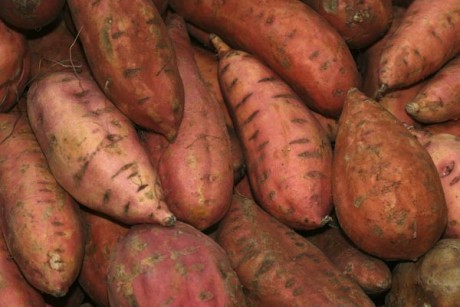Sweet potatoes love North Carolina’s sandy soil
Did you know that North Carolina is the Number One producer of sweet potatoes in the U.S.?
By Mary Conroy
More than 40 percent of the national supply of sweet potatoes comes from North Carolina. Sweet potatoes are grown mostly in the Coastal Plain region, where well-drained, sandy soil benefits this root vegetable.
Johnston County leads all others in producing sweet potatoes.
Sweet potatoes will grow from May through late October. They can be started from plants called “slips.” Always buy plants grown from certified disease-free roots.
Transplant the slips in warm soil. Set them 12 to 18 inches apart, preferably on a wide, raised ridge about 8 inches high. A ridge not only dries better in the spring but also warms earlier than an unridged area.
It’s a good idea to rotate your sweet potato crop yearly.
When buying sweet potatoes to eat, select sound, firm roots. For the most food value, choose sweet potatoes of a deep orange color. These vegetables are low in sodium, cholesterol- free, fat-free, high in fiber, and they contain minerals and vitamins A, C and E.
Once you purchase your sweet potatoes, handle them carefully to prevent bruising. Store them in a dry, unrefrigerated bin kept at about 55–60 degrees F. Do not refrigerate them, because temperatures below 55 degrees F. will chill this tropical vegetable and give it a hard core and undesirable taste when cooked.
Recommended varieties (all are 100 days to harvest)
- Beauregard: light purple skin, dark orange flesh, extremely high yielder.
- Bush Porto Rico: compact vines, copper skin, orange flesh, heavy yield.
- Centennial: orange skin and flesh, stores well, resistant to internal cork and wilt.
- Georgia Jet: red skin, orange flesh, somewhat cold tolerant.
- Jewell: orange flesh, good yield, excellent keeper.
- Sumor: ivory to very light yellow flesh, may be substituted for Irish potatoes in very warm regions.
To do in July
Continue fertilizing garden vegetables.
Give landscape plants a second feeding of fertilizer.
Take soil samples from your lawn area for testing. Soil sample boxes are available at the county Cooperative Extension Center.
Set out plants of Brussels sprouts and collards in mid-July.
Begin your fall vegetable garden by planting beans, carrots and tomatoes.
Start broccoli, cabbage and cauliflower plants in peat pots to transplant into the vegetable garden in mid-August.
Begin repotting overgrown houseplants.
Prune bleeder trees like maple, dogwood, birch and elm.
Prune the fruiting canes of raspberry and blackberry plants after harvest is over. Cut canes at ground level.
Prune off dieback limbs on hybrid rhododendron.
Trim hedges as needed.
Continue pruning white pines and narrow-leaf evergreens such as juniper early in July.
Do not prune spring flowering shrubs now.
Remove faded flowers on crape myrtle and flowering perennials to encourage a second flowering.
Shear red-tip photinia in the last week of July or the first week of August for red foliage through the winter.
Pinch your chrysanthemums the first week only.
Look around to see if your home landscape can use additional shade trees, and where they should go.
If you see blossom-end rot on tomatoes, they may be getting too little rain or not enough lime.
In dry weather, both your vegetable garden and landscape plants will benefit from a good soaking watering. Slow watering will penetrate the root zone better.
-
Share this story:


